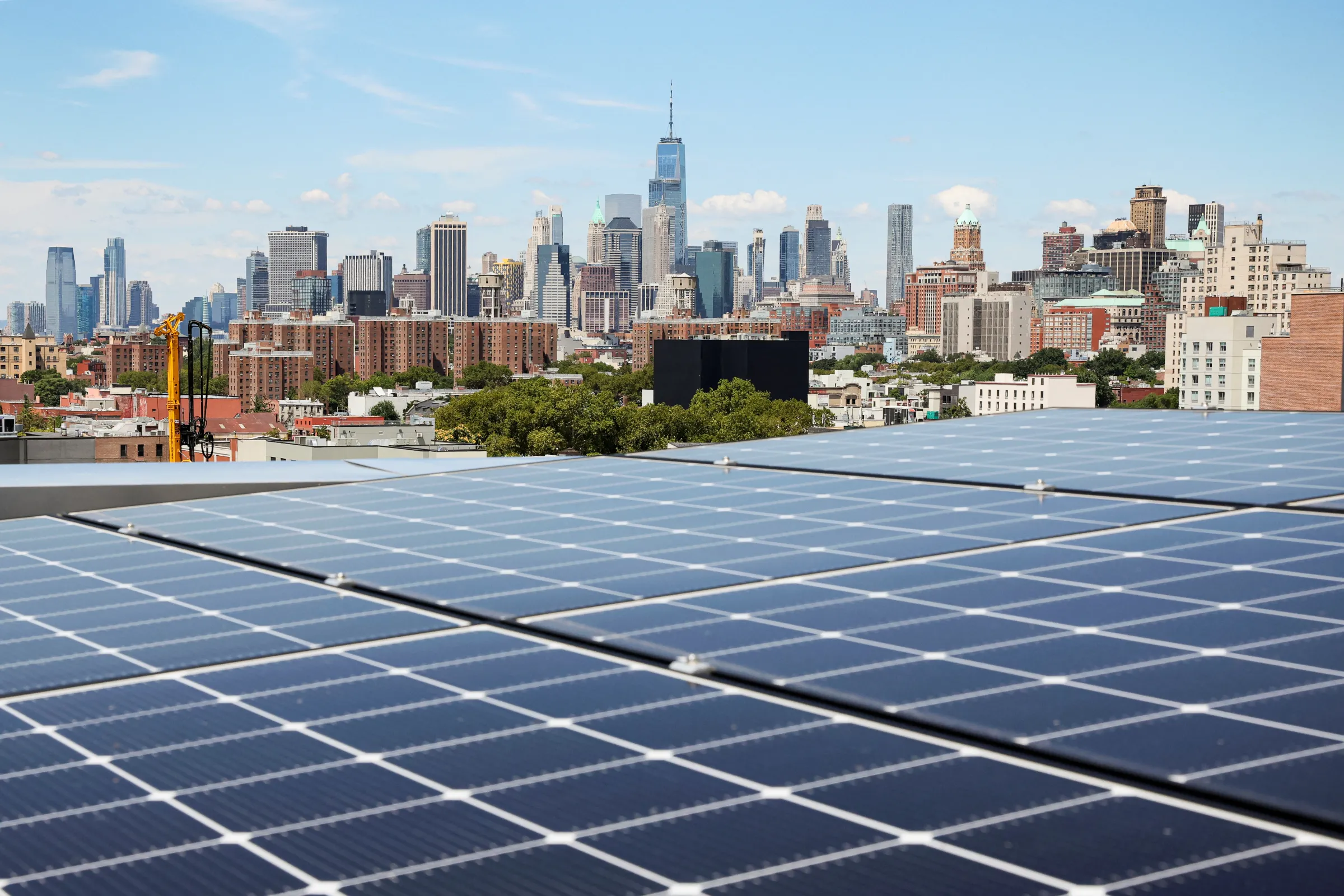How can U.S. cities keep up climate action under Trump?

Solar panels are seen along with a view of the neighborhood and lower Manhattan from the rooftop of Timber House, in Brooklyn, New York, U.S., August 16, 2022. REUTERS/Brendan McDermid
What’s the context?
Trump's moves and funding cuts to limit climate action have been aggressive, but local governments still have significant powers.
WASHINGTON - U.S. President Donald Trump's administration has significantly ramped up efforts to halt the federal focus on climate change, with Trump himself dismissing climate change as a "con job" to the United Nations General Assembly last month.
Yet local governments have significant powers to reduce global-warming emissions, regardless of what happens in Washington.
Hundreds of U.S. cities and nearly all 50 states have climate action plans that aim to decrease or even achieve “net zero” emissions through policies on renewable energy, transportation and green buildings.
Local governments also can see the impacts of climate-related natural disasters like hurricanes and wildfires more closely, potentially driving more action at the ground level.
So what powers do local officials have to keep up momentum on these issues under the Trump administration?
Why do local governments matter on climate action?
More than 80% of the U.S. population lives in cities, and urban areas globally account for nearly three-quarters of greenhouse gas emissions. That means emissions reduction efforts will have to focus on urban areas.
Even amid federal policy changes, continued action by cities could help the United States meet more than two-thirds of its goal of reducing emissions by more than 61% by 2035, according to research by the University of Maryland.
During Trump's first term from 2017 to 2021, he weakened the federal focus on climate change, prompting cities and states to organise along with companies and philanthropy. Those networks have grown since then.
Hundreds of cities have climate action plans in place, with most covering energy-efficient buildings, electric vehicles, waste operations, public transportation and renewable energy.
How have Trump's changes affected local work on climate change?
The federal government has halted and even taken back funding for a variety of programmes with direct local implications.
Notable examples include the $7 billion Solar for All programme that helped place solar panels on apartment buildings and homes in poor neighbourhoods.
The administration also ended the $3 billion Environmental and Climate Justice block grant programme that assisted local groups in addressing pollution and climate change concerns in poor areas.
The $2 billion Community Change grant programme, which supported community-driven climate change efforts, particularly in smaller communities, has also been shut down.
Up in the air is the fate of new "direct pay" tax provisions that allow local governments to reap the tax benefits of renewable energy development that were previously open only to companies, thus making the projects financially feasible.
Trump has also directly attacked state-level climate action, in April directing the Department of Justice to challenge such laws and regulations.
"What the federal government is doing right now on climate is causing a lot more people to feel a lot more urgency around climate – and to feel a lot more motivation to do something about it," said Jack Hanson, executive director of Run on Climate, which supports climate-focused candidates and officials.
Where can cities continue to make progress?
In the United States, local governments can decide on building codes, land use and transportation systems. Some may own their own electrical utilities or oversee power purchases and with municipal buildings and vehicle fleets, local officials can directly implement green policies to reduce emissions.
Buildings alone are responsible for nearly a third of U.S. emissions. Local authorities can require efficient construction or rehabilitations, phase out the use of fossil fuels and decide on density and parking requirements.
Local authorities can also offer subsidies to businesses and homeowners to retrofit buildings to be more energy efficient.
Transportation makes up almost another third of U.S. emissions. Local zoning and planning decisions guide where residences and businesses are located and, in turn, can affect commuting routes and times.
Many cities are making bicycle and foot travel easier, subsidizing electric vehicles, installing chargers and electrifying bus systems.
Cities account for 80% of U.S. energy consumption, and local authorities can influence where that electricity comes from.
About 2,000 communities across the United States get power from publicly owned utilities, for instance, while many others purchase renewable energy or produce it themselves.
Hundreds have programmes and financial incentives to help residents install solar panels.
Cities also have control over waste management, parks and green space as well as flood and wildfire mitigation.
What about funding?
The Trump administration's cuts do pose major obstacles to local action. But cities can raise money in a variety of ways and are exploring more options.
"One of the biggest changes in 2025 is a lot of cities are talking about how they might do local elections to secure funding and approval for local projects," said Phoenix, Arizona Mayor Kate Gallego.
Local authorities have also increasingly sought to access international finance, facilitated by multilateral institutions such as the World Bank.
Globally, private finance for urban climate finance has more than tripled since 2017, with private entities providing nearly half of such funding last year.
City officials and mayors are looking ahead to the COP30 climate talks in Brazil in November to build connections with partners and seek private investment to move ahead with clean energy goals.
(Reporting by Carey L. Biron. Editing by Anastasia Moloney and Ellen Wulfhorst)
Context is powered by the Thomson Reuters Foundation Newsroom.
Our Standards: Thomson Reuters Trust Principles
















